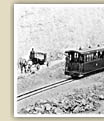
The construction of a railway network was one of the major achievements of Harilaos Trikoupis. However, the bankruptcy of 1893 did not allow for the completion of the project, which was eventually terminated
at the beginning of the twentieth century.
In the period 1897-1902, only 100 kilometres of railway lines were
in operation but, in the same period, agreements were contracted
that would lead to the construction of a further 520 kilometres
of track by 1909. In total, 1,600 kilometres of track were constructed
by that year. In 1902 the Society of the Greek Railways was established,
the last company to be involved in the construction and management
of the Greek railway lines. By 1909, with the construction complete,
it was clear that the costs had broken down to a 62% contribution
from the state, and 38% from private sources. In 1920 the Railways
of the Greek State (ĶEK) were established.
The railway network transported commercial products, the output of which was increasing
at a normal rate. This boosted the revenues of the railways.
The new transport system supported local trade but also concerned exports abroad such as raisins. By contrast,
the number of passengers did not increase. It is perhaps interesting to note that the creation of a railway network
was not accompanied by a concomitant industrial development.
|
 |
